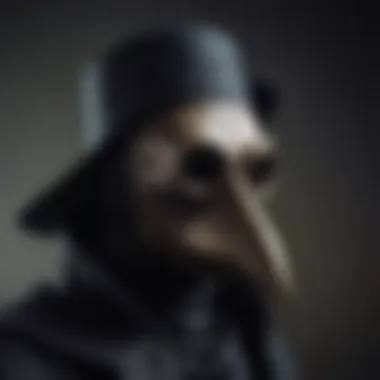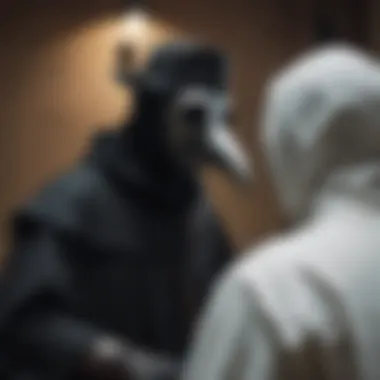Unraveling the Enigmatic World of the Plague Doctor: A Historical Exploration


The Plague Doctor, a figure shrouded in mystery and historical intrigue, possesses a compelling allure that transcends time. Step into the enigmatic realm of these iconic individuals as we embark on a journey to unravel the layers of their significance, attire, practices, and cultural reverberations through the annals of history. With a keen focus on shedding light on the enigmatic persona of the Plague Doctor, we delve into narratives that evoke curiosity and contemplation, illuminating the shadowed corners of the past.
Historical Significance
In the tapestry of history, the presence of the Plague Doctor stands as a testament to a bygone era plagued by disease and mortality. A pivotal figure during the times of the bubonic plague, these enigmatic healers roamed amidst death and despair, offering a glimmer of hope in the darkened alleys of afflicted townships. Their distinctive attire, comprising beaked masks and flowing robes, not only served a practical purpose but also symbolized a beacon of scientific progress in the face of adversity.
Mysterious Attire
The attire of the Plague Doctor, featuring a long cloak, leather gloves, and the infamous beaked mask, holds a mystique that continues to captivate imaginations. The beak, often filled with aromatic herbs to ward off 'miasma,' was a dual-purpose apparatus that protected the wearer from foul odors and purported 'bad air.' This enigmatic ensemble not only shielded the physician from the harsh realities of their environment but also served as a symbol of both fear and hope during tumultuous times.
Medical Practices
Unveiling the arcane medical practices of the Plague Doctor unveils a world entrenched in a blend of empirical observation and superstition. From bloodletting and herbal remedies to the rudimentary understanding of contagion, these healers navigated treacherous waters of medical knowledge with unwavering determination. Despite the limitations of their era, the dedication and commitment of the Plague Doctor to alleviate suffering and combat contagion remain a testament to the resilience of the human spirit in the face of adversity.
Cultural Impact
Beyond their medical duties, the Plague Doctor has transcended into the realm of cultural symbolism, becoming an emblem of resilience, fear, and the enduring battle against pestilence. With a legacy that spans centuries, these enigmatic figures have inspired art, literature, and even contemporary fashion, serving as a reminder of humanity's enduring struggle against the invisible forces of disease. The cultural impact of the Plague Doctor resonates through time, echoing their solemn oath to serve and protect amidst the shadows of uncertainty.
Introduction to Plague Doctors
In this segment of the article, we delve into the intriguing world of the Plague Doctor, unraveling the historical significance, mysterious attire, medical practices, and cultural impact of these enigmatic figures. The Introduction to Plague Doctors sets the stage for a comprehensive exploration of a topic shrouded in historical mystery and modern fascination. By examining the origins, purpose, and distinctive attire of these unique medical professionals, readers will gain a deeper understanding of the role they played in combating deadly diseases.
Origins of Plague Doctors
Medieval Europe


Medieval Europe serves as a pivotal era in the emergence of Plague Doctors. Amidst the ravages of pandemics like the Black Death, medical practitioners in Europe adopted distinct ways to protect themselves and treat patients. The landscape of Medieval Europe, marked by sparse medical knowledge and widespread superstitions, greatly influenced the development and evolution of the Plague Doctor's persona. The emergence of the Plague Doctor during this tumultuous period signaled a shift towards more structured medical practices, albeit rooted in the limitations of the era.
Black Death Pandemic
The Black Death Pandemic stands as a defining moment in the history of medicine and plague control. As one of the most devastating pandemics in human history, the Black Death shaped the practices and perceptions of healthcare professionals during its time. The terror and destruction wrought by the Black Death propelled the necessity for specialized individuals, such as Plague Doctors, to confront the spread of disease. The epidemic's ramifications reverberate through history, influencing both medical practices and societal responses to infectious outbreaks.
Purpose and Role
Disease Containment
Disease containment stands at the core of a Plague Doctor's responsibilities, embodying the essence of their role in combating epidemics. The meticulous practices of isolating, treating, and monitoring infected individuals underscored the essential nature of disease containment during outbreaks. The unique focus on preventing the spread of contagion highlights the imperative role played by Plague Doctors in safeguarding public health and minimizing the impact of epidemics.
Patient Care
Patient care, though secondary to disease containment, remained a crucial facet of a Plague Doctor's duties. Providing comfort, assistance, and palliative care to afflicted individuals showcased the compassionate side of these otherwise enigmatic figures. The juxtaposition of rigorous disease control measures with empathic patient care encapsulated the comprehensive approach adopted by Plague Doctors towards managing epidemics.
Distinctive Attire
Bird-like Mask
The iconic Bird-like Mask synonymous with Plague Doctors holds a myriad of symbolic and practical significances. Serving as a visual representation of the profession, the bird-like mask not only shielded the wearer from miasma but also evoked a sense of foreboding and mystery. The distinctive silhouette of the mask effectively conveyed the authority and poignancy associated with the Plague Doctor's presence, making it a recognizable emblem of epidemic control.
Protective Garments
Protective garments donned by Plague Doctors not only served utilitarian functions but also contributed to their enigmatic aura. The layers of protective clothing, often waxed and substantial, not only shielded individuals from infection but also obscured their identity, adding to the air of mystery. The transformation brought about by the distinctive attire of Plague Doctors underscores the intersection of functionality, symbolism, and historical context in shaping their unique visual identity.


Medical Practices of Plague Doctors
In the vast tapestry of the historical evolution of medicine, the practices of plague doctors stand as a significant thread, woven with meticulous care and attention. This article embarks on a journey to unravel the essence of these practices within the context of their time, shedding light on their role in combating the relentless scourge of infectious diseases. Delving into the realm of medical practices of plague doctors allows us to grasp the complexities of healing methodologies from centuries past and appreciate the rudimentary yet pioneering efforts undertaken to safeguard public health.
Treatment Methods
Herbal Remedies
Exploring the intricate tapestry of medical practices employed by plague doctors unveils the profound significance of herbal remedies as a cornerstone of their treatment arsenal. Amidst the stark backdrop of limited scientific understanding, these concoctions crafted from nature's bounty served as linchpins of hope in the face of adversity. The utilization of herbal remedies not only reflected the prevailing belief in the healing prowess of botanical agents but also underscored the pragmatic ingenuity of adapting resources to combat diseases. Despite the inherent challenges and uncertainties surrounding their efficacy, herbal remedies stood as stalwart companions in the perpetual battle against unseen threats, embodying the fusion of ancient wisdom and empirical experimentation.
Bloodletting
A practice as ancient as humanity itself, bloodletting emerged as a stark yet intriguing facet of the therapeutic approaches employed by plague doctors. The act of deliberately shedding blood, ostensibly to restore balance or expel toxins, was ensconced in the belief systems of the time, intertwining mysticism with pragmatism. While bloodletting's precise efficacy remains shrouded in historical ambiguity, its symbolic resonance within the overarching narrative of medical practices of plague doctors is unmistakable. The ritualistic nature of bloodletting, coupled with its perceived purgative properties, added a layer of complexity to the intricate web of treatments woven by these enigmatic healers.
Challenges and Limitations
Understanding of Diseases
Nestled within the intricate tapestry of medical pursuits, the challenge of understanding diseases loomed large over the endeavors of plague doctors. In an era bereft of modern diagnostic tools and molecular elucidation, the comprehension of diseases relied heavily on observational acumen and deductive reasoning. Navigating the labyrinthine landscape of epidemics demanded not only courage but also intellectual fortitude to discern patterns amidst chaos. The evolution of medical understanding, propelled by the tireless efforts of plague doctors, serves as a testament to humanity's enduring quest for knowledge amidst adversity.
Medical Knowledge of the Time
At the crossroads of antiquated wisdom and burgeoning enlightenment lay the continuum of medical knowledge that guided the hands and minds of plague doctors. Anchored in the prevailing paradigms of humoral theory and metaphysical doctrines, the medical knowledge of the time encapsulated a mosaic of beliefs and practices. Though rudimentary by contemporary standards, these foundations paved the way for future advancements in medical science, laying bare the interplay between tradition and innovation. The symbiotic relationship between past insights and nascent discoveries sculpted the landscape of medical practices, shaping the destinies of both healers and the ailing with equal measure.
Cultural Impact and Legacy


The section on Cultural Impact and Legacy delves deep into the enduring significance of the Plague Doctor phenomenon. This element is crucial in understanding how these figures have transcended time and left a lasting imprint on various aspects of culture. By exploring the influence of Plague Doctors on literature, art, and contemporary popular culture, we get a glimpse into the complex interplay between historical events and modern interpretations.
Literary Representation
The Masque of the Red Death by Edgar Allan Poe
In discussing The Masque of the Red Death by Edgar Allan Poe, we uncover the profound impact of Poe's literary work on shaping the macabre imagery associated with the Plague Doctor. This tale weaves a narrative that merges themes of mortality, societal decay, and inevitable demise, encapsulating the grim aura surrounding the Plague Doctor archetype. The story's ability to evoke fear and introspection makes it a fitting inclusion in this exploration of cultural symbolism.
Plague Doctor in Pop Culture
The portrayal of the Plague Doctor in popular culture serves as a bridge between historical reality and contemporary imagination. From video games to films, the presence of Plague Doctors signifies a fusion of history with artistic license, offering new perspectives on these enigmatic figures. This analysis sheds light on how the Plague Doctor has become a symbol of mystery and foreboding in today's media landscape.
Symbolism and Mythology
Representation of Death
The symbolic portrayal of death through the Plague Doctor underscores humanity's eternal fascination with mortality and the afterlife. This theme resonates across cultures and time periods, making the Plague Doctor a potent symbol of both fear and transcendence. By examining the multifaceted layers of meaning behind this representation, we gain insight into the intricate tapestry of symbolism that has endured through centuries.
Iconic Image in Art
The iconic image of the Plague Doctor in art showcases the convergence of historical context and artistic interpretation. Through paintings, sculptures, and other visual mediums, artists have immortalized the haunting visage of the Plague Doctor, capturing the essence of a bygone era plagued by disease and despair. This exploration highlights how art serves as a vessel for preserving the legacy of the Plague Doctor in the annals of cultural history.
Modern Interpretations
Steampunk Aesthetics
The infusion of Steampunk aesthetics into the imagery of the Plague Doctor signifies a modern reinvention of historical tropes. Drawing on elements of retro-futurism and industrial design, Steampunk breathes new life into the iconic figure, reimagining it within a realm of fantastical innovation and alternative history. This segment elucidates how Steampunk aesthetics contribute to reshaping the narrative surrounding the Plague Doctor for contemporary audiences.
Fashion and Design
The incorporation of Plague Doctor motifs into fashion and design showcases the versatility of this historical archetype in influencing contemporary trends. From runway couture to casual wear, the allure of the Plague Doctor's aesthetic has seeped into mainstream fashion, embodying a mix of Gothic elegance and macabre allure. By examining the intersection of fashion and history, we uncover how the legacy of the Plague Doctor continues to captivate designers and consumers alike.



